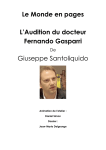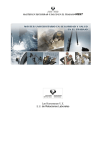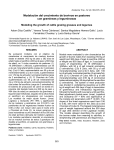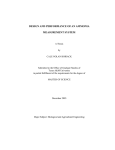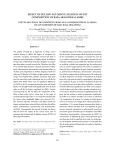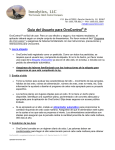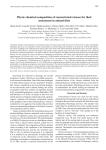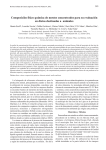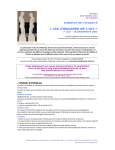Download efecto del sistema de distribución del alimento en el cebo del cerdo
Transcript
EFECTO DEL SISTEMA DE DISTRIBUCIÓN DEL ALIMENTO EN EL CEBO DEL CERDO IBERICO CRUZADO CON DUROC EFFECT OF THE FOOD DISTRIBUTION SYSTEM ON THE FATTENING OF IBERIAN PIG CROSSED WITH DUROC J. Luis Criado1, J. María Castel2, Manuel Delgado-Pertíñez2* Centro Veterinario Carmona. Calle Lora del Río no. 2, 41410-Carmona, Sevilla, España. (jlcriado@ porgloges.com). 2Escuela de Ingeniería Técnica Agrícola. Departamento de Ciencias Agroforestales. Universidad de Sevilla. Ctra. Utrera km 1, 41013 Sevilla, España. (pertinez@ us.es). 1 Resumen Abstract Debido a la intensificación de los sistemas de producción en porcino Ibérico se observa un aumento en la implantación de la alimentación líquida, pero hay pocos trabajos que muestren sus ventajas en esta raza. El objetivo de este trabajo fue analizar técnica y económicamente el modo de distribución del pienso durante el engorde de cerdos cruzados Ibérico con Duroc. Se utilizaron 156 cerdos y se ensayaron tres dietas: 1) alimento estándar en harina distribuido en seco ad libitum (PSAL); PSAL pero racionado en seco (PSR); PSAL racionado y en forma líquida o sopa (SO). Las dietas fueron suministradas en tres fases del crecimiento: de 35 a 50 kg de peso de 50 a 100 kg y de 100 kg hasta el sacrificio. Aunque al principio del crecimiento no hubo diferencias significativas posteriormente se observaron diferencias siendo mayores los pesos de los cerdos alimentados con PSAL y más bajos los que recibieron PSR. Los índices de conversión fueron más bajos para SO (4.22) comparado con PSR (4.37) y PSAL (4.72) para para todo el período de crecimiento. La dieta más cara fue PSAL y la más económica la SO. Con la dieta PSAL los cerdos alcanzaron el peso comercial de cebo (130 kg) tres semanas antes que con la dieta SO, pero con ésta se consiguió un menor coeficiente de variación del peso durante el periodo de cebo. Due to the intensifying of the breeding systems of the Iberian pig, an increase was observed in the implementation of feeding liquids, although there are few investigations that show their advantage on this breed. The aim of this investigation was to analyze, in technical and economical terms, the form of distribution of the fodder during the fattening of crossbred Iberian pigs with Durocs. One hundred and 156 pigs were used and three diets were tested: 1) standard feed in the form of flour, distributed in dry form ad libitum (PSAL); PSAL but dry rationed (PSR); PSAL rationed and as a liquid or soup (SO). The diets were supplied in three growth stages: from 35 to 50 kg of live weight, from 50 to 100 kg and from 100 kg until sacrifice. Although at the beginning of growth there were no significant differences, these appeared afterwards, and the weights of the pigs fed with PSAL were greater, while those fed with PSR were lowest. The conversion indexes were lower for SO (4.22) compared to PSR (4.37) and PSAL (4.72) for the entire period of growth. The most expensive diet was PSAL and the cheapest was SO. With the PSAL diet, pigs reached the commercial fattening weight (130 kg) three weeks earlier than with the SO diet, although with the latter, a lower weight variation coefficient was reached during the fattening period. Palabras clave: Porcino ibérico, alimentación líquida, crecimiento, costos. Key words: Iberian Pig, liquid feed, growth, costs. Introduction Introducción E S pain, along with Germany, is number 1 in pork production within the European Union, with an important increase in the Iberian pig, an autochthonous breed that stands out by the quality of its products, and that accounts for 11 % of the national census, with nearly 300 000 breeders spaña, junto con Alemania, tiene el primer lugar en producción porcina dentro de la Unión Europea, destacando el crecimiento importante * Autor responsable v Author for correspondence. Recibido: Julio, 2008. Aprobado: Enero, 2009. Publicado como ARTÍCULO en Agrociencia 43: 791-801. 2009. 791 AGROCIENCIA, 16 de noviembre - 31 de diciembre, 2009 del porcino Ibérico, raza autóctona caracterizada por la calidad de sus productos y que representa 11 % del censo nacional, con cerca de 300,000 reproductoras (MAPA, 2007). El sistema de alimentación líquida está implantado en Alemania, Francia, Holanda y Dinamarca, donde poco más del 60 % de los cerdos de engorde son alimentados mediante este sistema (Lizardo, 2004). En 2004 en España sólo había unas 60 granjas con alimentación líquida, menos del 2 % del total (Lizardo, 2004), de las cuales sólo cuatro eran de cerdo Ibérico. No obstante, se observa un aumento en la implantación de ese tipo de alimentación, especialmente en porcino Ibérico, debido a sus ventajas y por la intensificación de los sistemas de producción (Criado, 2008)[3]. El uso de la alimentación líquida tiene ventajas, pero tiene algunos inconvenientes (Gadd, 2005) como elevados costos de inversión (Lizardo, 2004; Rodríguez-Estévez et al., 2007) y el aumento de la producción de purines, aunque este último se debería a una deficiente optimización de la mezcla del agua con el alimento sólido (Heidenreich et al., 2000; ITP 2000; Lizardo et al., 2005). La tasa de dilución puede variar de 2 a 4 L agua kg-1 pienso (Le Treut y Guillou, 2003), siendo habitual una tasa de dilución agua/pienso de 2.5:1 a 3:1, pudiendo llegar hasta 4:1 en cerdos racionados a los que se quiera proporcionar una sensación temporal de saciedad (RodríguezEstévez et al., 2007). Una ventaja del uso de la alimentación líquida es la mejora de todos los índices técnicos y durante el cebo se manifiestan mayores beneficios (Palomo, 2006a y 2007; Rodríguez-Estévez et al., 2007), aunque para Quémeré et al. (1988) y Jensen y Mikkelsen. (1998) esta mejora no es tan evidente. Según Torrallardona (2003) este sistema es de gran interés en la aplicación de programas de racionamiento en acabado o a programas multifase, ajustando la curva de consumo al potencial genético de crecimiento de los cerdos. Otra ventaja de la alimentación líquida es poder usar numerosos subproductos agroalimentarios, que pueden contribuir a reducir el costo de la dieta entre 10 % y 25 % y al menor impacto sobre el ambiente (Scholten et al., 2000; Palomo, 2007; Rodríguez-Estévez et al., 2007). Los beneficios sobre (MAPA, 2007). The liquid feed system has been introduced in Germany, France, the Netherlands and Denmark, where just over 60 % of fattening pigs are fed using this system (Lizardo, 2004). In 2004 there were only about 60 farms in Spain using liquid feed, less than 2% of the total amount (Lizardo, 2004), out of which only 4 were for Iberian pigs. However, there is an increase in the introduction of this type of feed, especially in Iberian pigs, due to its advantages and the intensifying of farming (Criado, 20083). The use of liquid feed has its advantages, yet there are some drawbacks (Gadd, 2005) such as high investment costs (Lizardo, 2004; Rodríguez-Estévez et al., 2007) and an increase in the production of purines, although the latter may be due to a deficient optimization of the mixture between water and the solid food (Heidenreich et al., 2000; ITP 2000; Lizardo et al., 2005). The dilution rate could vary from 2 to 4 L of water kg-1 of fodder (Le Treut and Guillou, 2003), when the habitual practice would be a dilution rate of water/fodder of 2.5:1 to 3:1, and up to 4:1 in fed pigs that must be given a sense of temporary hunger satisfaction (Rodríguez- Estévez et al., 2007). One advantage of the use of liquid feed is the improvement of all the technical indexes and during fattening is when the most benefits become manifested (Palomo, 2006a y 2007; Rodríguez-Estévez et al., 2007), although for Quémeré et al. (1988) and Jensen and Mikkelsen. (1998) this improvement is not as evident. According to Torrellardona (2003) this system is of great interest in the application of feeding programs en acabado or to multiphase programs, adjusting the consumption curve to the genetic growth potential of the pigs. Another advantage of liquid feed is being able to use numerous food and agriculture sub products, that can help reduce the cost of the diet 10 to 25 %, as well as the impact on the environment (Scholten et al., 2000; Palomo, 2007; Rodríguez-Estévez et al., 2007). The benefits on the environment are related to swine production in the reduction of manure and its pollutants, as well as in cheese and beer producers, whose sub products are used, avoiding its purification by costly procedures (Scholten et al., 2000; Criado, 200833). Juan Luis Criado comunicación personal, 2008 (Gerente y Director Técnico de la consultoría porcina “Centro Veterinario Carmona”; Miembro de la Real Academia Española de Ciencias Veterinarias; Coordinador de la página web 3tres3iberico.com, Director coordinador de los módulos 1 y 5 del Máster Universitario Origen, Producción y Transformación del cerdo Ibérico, Universidad Internacional de la Rábida). 3 792 VOLUMEN 43, NÚMERO 8 EFECTO DEL SISTEMA DE DISTRIBUCIÓN DEL ALIMENTO EN EL CEBO DEL CERDO IBERICO CRUZADO CON DUROC el ambiente se relacionan con la explotación porcina al disminuir el volumen de deyecciones y sus contaminantes, y además con las queserías y cerveceras cuyos subproductos son aprovechados evitando asi su depuración por procedimientos costosos (Scholten et al., 2000; Criado, 20083). El objetivo del presente trabajo fue analizar el efecto de la restricción alimenticia y administración en seco, y de la misma restricción con el efecto añadido de la forma de administración líquida, con respecto a la administración de alimento seco ad libitum sobre los rendimientos productivos y la variabilidad de peso vivo en el engorde de cerdos cruzados Ibérico con Duroc. Materiales y Métodos El ensayo se efectuó en una granja porcina de ciclo cerrado con ambiente controlado, situada en el término municipal de Alcalá de Guadaira (Sevilla, España), donde se producen cerdos Ibéricos 50 % (Ibéricos ´ Duroc) con un manejo intensivo en la fase reproductiva, en la de recrío y engorde hasta el sacrificio. Se usaron tres dietas cómo tratamientos: 1) alimento balanceado estándar en harina, distribuido en seco ad libitum (PSAL) en tolvas de hormigón de tres bocas diseñadas para alimentar 25 cerdos; 2) PSAL racionado en seco (PSR), distribuido manualmente sobre pilón corrido en un espacio de 50 cm lineales por cerdo, programando un consumo de 405 kg. (±5) de las 14 a las 37 semanas (Nieto et al., 2002; Palomo, 2006b; Barea et al., 2007); 3) PSAL racionado pero distribuido automáticamente en forma líquida o sopa (SO) sobre un pilón corrido para un espacio de 50 cm lineales por cerdo y con el mismo consumo que PSR; el pienso se incorporaba manualmente en la tolva de recepción del tanque de mezclas, donde se añadía la proporción de agua programada (relación agua/pienso 3:1). En el Cuadro 1 se muestra los ingredientes del alimento en cada fase de cebo y en el Cuadro 2 se muestra su composición. Las dietas líquidas se prepararon automáticamente en un tanque experimental de mezclas usando el programa informático Big-Dufmall; antes de cada distribución se agitó la mezcla 10 min a 69 rpm; para los consumos estimados se utilizaron los parámetros monitorizados obtenidos de experiencia anteriores en relación al consumo de pienso ad libitum. El alimento líquido se distribuyó tres veces al día, según un plan de racionamiento para cerdos precoces grasos Landrace ´ Duroc, introducido en BigDufmall. El alimento seco se distribuyó tres veces al d, según la programación de consumo establecida. Al no existir datos específicos de las necesidades de nutrientes del cerdo Ibérico cuando se realizó el presente trabajo, la formulación de alimentos se efectuó con recomendaciones para razas precoces, a pesar de que la raza Cuadro 1.Ingredientes (%) y costo total (€ kg-1) del alimento en cada fase de cebo†. Table 1.Ingredients (%) and total cost (€ kg-1) of the feed in each stage of fattening†. Ingrediente Fase 1 Fase 2 Fase 3 Cebada Maíz Trigo Salvado de cereales Pulpa de remolacha Harina de gluten de maíz Girasol 32-34 Soja 44 Harina de pescado 60-65 Manteca de cerdo Carbonato cálcico Fosfato bicálcico Sal DL-metionina L-lisina Corrector mineral vitamínico¶ € kg-1 dieta 29.71 31.52 10.00 3.00 18.00 3.01 2.06 0.78 1.04 0.30 0.005 0.17 0.40 0.214 30.00 24.68 10.00 7.00 4.00 18.47 2.78 0.98 1.32 0.36 0.003 0.004 0.40 0.199 31.00 10.00 30.00 4.83 7.00 10.34 4.00 1.10 1.02 0.31 0.40 0.198 † Fase 1, de crecimiento (35 a 50 kg peso vivo; 14 a 18 semanas de edad); Fase 2, de precebo (50 a 100 kg; 18 a 30 semanas); Fase 3, de engorde-acabado (100 kg al sacrificio; 30 a 37 semanas). ¶ Contenido por kg de alimento: Fase 1; 7000 UI vitamina A, 1500 UI vitamina D3, 15 mg vitamina E, 0.75 mg vitamina K3, 1 mg vitamina B1, 4 mg vitamina B2, 1.5 vitamina B6, 0.02 mg vitamina B12, 9 mg ácido pantoténico, 16 mg ácido nicotínico, 0.15 mg ácido fólico, 0.175 g colina, 100 mg Fe, 80 mg Mn, 20 mg Cu, 110 mg Zn, 0.5 mg I, 0.4 mg Co, 0.2 mg Se. Fases 2 y 3; 5600 UI vitamina A, 1200 UI vitamina D3, 12 mg vitamina E, 0.6 mg vitamina K3, 0.8 mg vitamina B1, 3.2 mg vitamina B2, 1.2 vitamina B6, 0.016 mg vitamina B12, 7.2 mg ácido pantoténico, 12.8 mg ácido nicotínico, 0.12 mg ácido fólico, 0.2 g colina, 100 mg Fe, 80 mg Mn, 20 mg Cu, 110 mg Zn, 0.5 mg I, 0.4 mg Cu, 0.2 mg Se. The aim of this paper is to analyze the effect of food restriction and dry supply, and of the same restriction, with the added effect of the liquid feed, in regard to the supply of dry food ad libitum on the productive yields and the variability of live weight on the fattening of Iberian pigs crossed with Duroc. Materials and methods The trial was carried out in a ciclo cerrado pig farm with a controlled environment, located in the municipality of Alcalá de Guadaira (Seville, Spain), where 50 % Iberian pigs are produced (Iberian ´ Duroc) with intensive handling in the phases of reproduction recrío and fattening until sacrifice. CRIADO et al. 793 AGROCIENCIA, 16 de noviembre - 31 de diciembre, 2009 Cuadro 2. Composición y valor nutritivo del alimento balanceado en cada fase de cebo†. Table 2. Composition and nutritional value of the balanced feed in each phase of fattening†. Nutriente¶ (% sobre producto fresco) Humedad Proteína bruta Cenizas Grasa bruta Fibra bruta Almidón Lisina Metionina Metionina-cistina Treonina Triptófano Calcio Fósforo disponible Sodio Acido Oleico Acido Linoleíco Energía neta (kcal kg-1) Energía digestible (kcal kg-1) Fase 1 Fase 2 Fase 3 10.88 10.84 10.21 16.96 16.70 14.16 5.37 5.68 5.20 4.51 5.06 6.07 4.00 4.84 4.00 42.03 -- 42.85 1.00 0.80 0.60 0.30 0.28 0.23 0.59 0.59 0.51 0.64 0.62 0.50 0.19 -- 0.16 0.85 0.85 0.80 0.34 0.35 0.30 0.16 0.15 0.15 1.19 1.45 1.88 1.20 1.31 1.32 2341 2284 2388 3325 3250 3350 † Fase 1, de crecimiento (35 a 50 kg peso vivo; 14 a 18 semanas de edad); Fase 2, de precebo (50 a 100 kg; 18 a 30 semanas); Fase 3, de engorde-acabado (100 kg al sacrificio; 30 a 37 semanas). ¶ Valores obtenidos por formulación usando el programa ALLIX 2000, tomando como base el sistema INRA de recomendaciones nutritivas y las tablas FEDNA de composición de alimentos (FEDNA, 2003). Ibérica presenta marcadas diferencias productivas y metabólicas como la velocidad de crecimiento, el depósito de proteína o la eficiencia energética (Fernández-Fígares et al., 2003; Rivera-Ferre et al., 2005). Las dietas fueron suministradas en tres fases del crecimiento: Fase 1, de crecimiento, 35 a 50 kg peso vivo y 14 a 18 semanas de edad; Fase 2, de precebo 50 a 100 kg, y 18 a 30 semanas; Fase 3, de cebo 100 kg al sacrificio y 30 a 37 semanas. Durante la experiencia, la cantidad de pienso administrada se aumentó alrededor de 10-15 % cada 15 d, ajustando la cantidad administrada en función de la capacidad real de consumo. Los alimentos fueron formulados para aportar los siguientes nutrientes: Fase 1, 2330 kcal kg-1, 16.5 g kg-1y 1.0 g kg-1; Fase 2, 2280 kcal kg-1, 16.5 g kg-1 y 0.8 g kg-1; Fase 3, 2380 kcal kg-1, 14.0 g kg-1 y 0.6 g kg-1, de energía neta, proteína y lisina total. Se utilizaron 156 cerdos (machos y hembras castrados) Ibéricos×Duroc, con 35.44±1.75 kg peso vivo inicial, proceden de camadas nacidas en la misma semana (en 2003) y fueron 794 VOLUMEN 43, NÚMERO 8 Three diets (treatments) were used: 1) standard flour balanced diet, distributed dry ad libitum (PSAL) in 3- mouthed concrete chutes, designed to feed 25 pigs; 2) PSAL dry rationed (PSR), distributed by hand on a corrido basin in a space of 50 cm per pig, with a programmed intake of 405 kg. (±5) from weeks 14 to 37 (Nieto et al., 2002; Palomo, 2006b; Barea et al., 2007); 3) PSAL, rationed but distributed automatically as a liquid or soup (SO) on a corrido basin in a space of 50 cm per pig and with the same intake as PSR; the fodder was incorporated by hand in the tolva de recepción of the mix tank, where the programmed proportion of water (water/fodder ratio 3:1). Table 1 shows the ingredients of the feed in each phase of the fattening, and Table 2 shows its composition. The liquid diets were prepared automatically in an experimental mix tank, using the Big-Dufmall; computer program: before each distribution, the mix was shaken for 10 min at 69 rpm; for estimated mixtures the monitores parameters were used, obtained from previous experience in relation to the consumption of dry food ad libitum. The liquid feed was distributed 3 times a d, according to a rationing plan for precocious fat Landrace ´ Duroc pigs, introduced into BigDufmall. The dry feed was distributed 3 times a day, according to the established consumption program. Due to an inexistence of data on the needs of nutrientes of the Iberian pig during the completion of this work, the formulation of feed was carried out under recommendations for precocious breeds, despite the Iberian breed presenting important productive and metabolic differences, such as the speed of growth, protein deposit or energetic efficiency (Fernández-Fígares et al., 2003; Rivera-Ferre et al., 2005). Diets were supplied in three gwoth phases: Phase 1, growth phase, 35 to 50 kg live weight and 14 to 18 weeks of age; Phase 2, prefattening, 50 to 100 kg, and 18 to 30 weeks; Phase 3, fattening 100 kg to sacrifice and 30 to 37 weeks. During the experience, the amount of fodder supplied was increased around 10-15 % every 15 d, adjusting the amount supplied based on the real capability of consumption. The feeds were formulated to provide the following nutrients: Phase 1, 2330 kcal kg-1, 16.5 g kg-1 and 1.0 g kg-1; Phase 2, 2280 kcal kg-1, 16.5 g kg-1 and 0.8 g kg-1; Phase 3, 2380 kcal kg-1, 14.0 g kg-1 and 0.6 g kg-1, of net energy, total protein and lysine. One hundred and fifty six Iberian×Duroc pigs (castrated males and females), with 35.44±1.75 kg of initial live weight proceed from the same litter bron on the same week (in 2003) and were randomly split into groups of 26 animals in 6 26 m2 (6.5×4 m) pens (2 for each diet). Pigs were weighed individually in 15 d intervals; In each weigh and in each pen, 11 pigs were randomly chosen to avoid the stress of always weighing the same pigs. For each pen, in each week and for the whole experiment, EFECTO DEL SISTEMA DE DISTRIBUCIÓN DEL ALIMENTO EN EL CEBO DEL CERDO IBERICO CRUZADO CON DUROC alojados aleatoriamente en grupos de 26 animales en 6 corrales (2 para cada dieta) de 26 m2 (6.5×4 m). Los cerdos se pesaron individualmente al inicio del ensayo y a intervalos de 15 d; en cada pesada y en cada corral se escogían aleatoriamente 11 cerdos aleatoria para evitar el estrés de pesar siempre a los mismos cerdos. Para cada corral, en cada semana y para todo el experimento se determinó el consumo de alimento, la ganancia media diaria (g d-1, GMD), el índice de conversión técnico (kg pienso kg-1 aumento de peso) y el índice de conversión económico (€ por consumo de pienso.kg-1 aumento de peso). El diseño experimental fue completamente aleatorizado con dos repeticiones, y los datos se analizaron con el modelo GLM univariante de SPSS (SPSS Inc., 2006). Para la variable peso vivo en cada semana (de 35 kg de peso vivo hasta sacrificio; semanas de edad 14 a 37) se analizó el efecto fijo de la dieta. Para las variables consumo, GMD e índices de conversión técnico y económico, se analizaron los efectos fijos de la dieta y la semana. Antes del análisis de varianza se realizó un análisis de normalidad de los datos mediante el coeficiente de asimetría y curtosis, y la prueba Levene’s para comprobar la homogeneidad de las varianzas. Para determinar diferencias entre medias se uso la prueba de Tukey (p£0.05). Resultados y Discusión Crecimiento En los Cuadros 3, 4 y 5 se presentan las variaciones del peso vivo a lo largo de las semanas de crecimiento para las diferentes dietas. Durante las dos primeras semanas de aplicación de las dietas en la fase 1, los pesos variaron significativamente a favor de la alimentación líquida, probablemente debido al estímulo de consumo que se obtiene al suministrar el pienso húmedo a animales que vienen de comer en seco, o bien simplemente al efecto de novedad. En las otras semanas de la fase 1 no hubo diferencias significativas entre los pesos como consecuencia de las dietas. Durante las fases 2 y 3, en las que los cerdos se adaptaron totalmente al tipo de dietas asignadas, hubo claras diferencias significativas en los pesos; siempre son mayores los pesos de los cerdos con dieta PSAL y son más bajos los pesos de aquellos alimentados con pienso seco racionado. En cuanto a la alimentación líquida, los cerdos presentaron pesos medios entre los de las dos dietas con pienso seco. Una de las observaciones más importantes es que algunos cerdos con dieta PSAL alcanzaron el peso comercial (130 kg) tres semanas antes que los que tienen los otros tipos the consumption of feed was determined, as well as the daily average gain (g d-1, GMD), the technical conversion rate (kg fodder kg-1 weight gain) and the economic conversion rate (€ per consumption of ofdder kg-1 weight gain). The results have been analyzed with The experimental design was completely randomized with two repetitions, and the data were analyzed with the SPSS univariant GLM model (SPSS Inc., 2006) [sic.]. For the live weight variable in each weeks (from 35 kg live weight until sacrifice; ages in weeks) the fixed effect of the diet was analyzed. For the variables of consumption, GMD and technical and economic conversion indices, the fixed effects of the diet and the week were analyzed. Before the variance analysis, there was a normality test for data using the asymmetry coefficient and curtosis, as well as Levene’s test for the homogeneity of the variances. The Tukey test was used to determine the differences between averages (p£0.05). Results and Discussion Growth Tables 3, 4 and 5 show the variations in live weight throughout the weeks of growth for the different diets. During the first two weeks of supplying the diets in phase 1, weights varied significantly in favor of liquid feed, probably due to the consumption incentive obtained by supplying liquid fodder to animals that have been eating dry food, or due to the novelty. In the other weeks of phase 1, there were no significant differences between weights as a consequence of the diets. During phases 2 and 3, in which pigs adapted entirely to the assigned diets, there were clear significant differences in weights; weights of pigs with PSAL diets are always greater and that of pigs fed with rationed dried food are lower. In regard to liquid feed, the pigs displayed middle steps between those with two diets with dry fodder. One of the most important observations is that some pigs on a PSAL diet reached the commercial weight (130 kg) three weeks before those on other types of feed, while those on the PSR diet needed a few more days, in relation to pigs on liquid diets, to reach a commercial weight. The variation coefficients (VC) as a measure of statistical dispersion related to the homogeneity of the group (Padilla, 2007; Di Pietre, 2007), reach over 10 % in the case of PSAL (Table 3). This circumstance is interesting, since one of the most CRIADO et al. 795 AGROCIENCIA, 16 de noviembre - 31 de diciembre, 2009 Cuadro 3. Efecto de la dieta† en el peso (kg) según semana de edad durante la primera fase del cebo (35 a 50 kg de peso vivo). Table 3. Effect of diet† on the weight (kg) according to the weeks old during the first phase of fattening (35 to 50 kg of live weight). Dieta¶ 14 SO PSR PSAL p§ Semana 16 18 36.55a±1.69 (5) 43.82±2.66 (6) 51.64±3.40 (7) 34.73b±1.34 (4) 41.86±3.1 (7) 49.82±4.01 (8) 35.05b±1.69 (5) 43.58±4.76 (11) 52.23±5.62 (11) ** ns ns † Media, ± desviación estándar y coeficiente de variación (entre paréntesis). ¶ PSAL: pienso o alimento balanceado estándar en harina distribuido en seco ad libitum; PSR: mismo pienso anterior pero racionado en seco; SO: mismo pienso racionado pero distribuido en forma líquida o sopa. § * p£0.05; ** p£0.01; *** p£0.001; ns: no significativo. Letras diferentes en una columna indican diferencias significativas (p£0.05). de alimentación, mientras que los alimentados con la dieta PSR precisarían unos días más, en relación a los cerdos con alimentación líquida, para alcanzar el peso comercial. Los coeficientes de variación (CV) como medida de dispersión estadística relacionada con la homogeneidad del grupo (Padilla, 2007; Di Pietre, 2007), superan el 10 % en el caso de PSAL (Cuadros 3, 4 important aims in fattening is weight homogeneity in regard to age; in this sense, it is important to observe that the consumption of the PSR diet in phases 2 and 3 showed a higher VC than that of the liquid diet (Table 4 and 5). The most weight homogeneity with rationed diets could be explained by the lower competition between pigs for the food, since each one had the same space in the trough at the same time (Rasmussen et al., 2006) and in these groups there were less hierarchies and therefore less fights. In the whole average daily gain (ADG) for each growth phase (Table 6), there was not a significant effect of the diet, although in the whole period there were significant differences favoring the PSAL diet (696 g), the SO diet being at an intermediate level (591 g) between PSAL and PSR (555 g). The results confirm the most important growth of pigs fed with PSAL, achieving greater weight by the end of the 37 weeks, with nearly 20-25 kg more than the pigs fed with fodder, whether dry rationed or distributed in liquid form. Results with liquid feed do not confirm the results obtained by other authors, who claim better growth with liquid feed (Lizardo et al., 2005; Palomo, 2006a; Rodríguez-Estévez et al., 2007), although Quemeré et al. (1988) and Jensen and Mikkelsen (1998) see no differences once the consumption/growth curve is optimized, which confirms the positive correlation consumption and average daily gain. When analyzing the average results obtained in later experiences (data not Cuadro 4. Efecto de la dieta† en el peso (kg) según semana de edad durante la segunda fase de cebo (50 a 100 kg de peso vivo). Table 4.Effect of the diet† on the weight (kg) according to the weeks of age during the second phase of fattening (50 to 100 kg of live weight). Dieta¶ SO PSR PSAL P§ Semana 20 22 24 26 28 30 59.5ab±3.78 (6) 56.95b±4.33 (8) 61.64a±6.92 (11) * 67.14b±3.89 (6) 65.18b±5.09 (8) 72.55a±7.92 (11) *** 74.09b±3.87 (5) 69.05c±4.39 (6) 80.64a±9.30 (12) *** 82.18b±4.82 (6) 77.00b±5.56 (7) 88.09a±11.00 (12) *** 89.05b±4.94 (6) 82.32c±5.40 (7) 94.82a±10.02 (11) *** 99.41a±5.99 (6) 92.45b±6.01 (7) 105.36a±12.67 (12) *** † Media, ± desviación estándar y coeficiente de variación (entre paréntesis). PSAL: pienso o alimento balanceado estándar en harina distribuido en seco ad libitum; PSR: mismo pienso anterior pero racionado en seco; SO: mismo pienso racionado pero distribuido en forma líquida o sopa. § * p£0.05; ** p£0.01; *** p£0.001; ns: no significativo. Letras diferentes en la misma columna indican diferencias significativas, (p£0.05). ¶ 796 VOLUMEN 43, NÚMERO 8 EFECTO DEL SISTEMA DE DISTRIBUCIÓN DEL ALIMENTO EN EL CEBO DEL CERDO IBERICO CRUZADO CON DUROC Cuadro 5. Efecto de la dieta† en el peso (kg) según semana de edad durante la tercera fase de cebo (100 kg peso vivo a sacrificio). Table 5.Effect of the diet† on the weight (kg) according to the weeks of age during the thrid phase of fattening (100 kg live weight to sacrifice). Dieta ¶ SO PSR PSAL P§ Semana 32 110.82b ± 6.75 (6) 102.91c ± 7.35 (7) 119.77a ±14.79 (12) *** 34 119.64b ± 6.45 (5) 113.41b ± 7.02 (6) 136.55a ± 14.40 (11) *** 37 133.18b ± 4.31 (3) 125.64c ± 7.21 (6) 149.32a ± 13.63 (9) *** † Media, ± desviación estándar y coeficiente de variación (entre paréntesis). PSAL: pienso o alimento balanceado estándar en harina distribuido en seco ad libitum; PSR: mismo pienso anterior pero racionado en seco; SO: mismo pienso racionado pero distribuido en forma líquida o sopa. § * p£0.05; ** p£0.01; *** p£0.001; ns: no significativo. Letras diferentes en una columna indican diferencias significativas (p£0.05). ¶ y 5). Esta circunstancia es interesante ya que uno de los objetivos más deseados en el cebo es la homogeneidad de los pesos en función de la edad; en este sentido es importante observar que el consumo de la dieta PSR en las fase 2 y 3 mostró un CV superior al de la dieta líquida (Cuadro 4 y 5). La mayor homogeneidad del peso con las dietas racionadas podría explicarse por la menor competencia entre los cerdos por el alimento, pues cada uno disponía del mismo espacio de comedero al mismo tiempo (Rasmussen et al., 2006) y en estos grupos se establecían menos jerarquías y en consecuencia menos peleas. En la ganancia media diaria (GMD) conjunta para cada fase de crecimiento (Cuadro 6) no hubo un efecto significativo de la dieta, pero en el período conjunto sí hubo diferencias significativas a favor de la dieta PSAL (696 g), estando la dieta SO a nivel intermedio (591 g) entre PSAL y PSR (555 g). Estos resultados confirman el crecimiento más importante de los cerdos alimentados con PSAL, consiguiendo un mayor peso al final de las 37 semanas con cerca de 20-25 kg más que los cerdos alimentados con pienso seco racionado o distribuido en forma líquida. Los resultados con la alimentación líquida no confirman los obtenidos por otros autores, quienes indican un mejor crecimiento con el alimento líquido (Lizardo et al., 2005; Palomo, 2006a; Rodríguez-Estévez et al., 2007), aunque Quemeré et al. (1988) y Jensen y Mikkelsen (1998) no observan diferencias una vez optimizada la curva consumo/crecimiento, lo que constata la correlación positiva entre consumo y ganancia media diaria. Al analizar los resultados medios obtenidos en experiencias posteriores (datos no publicados) se ha observado mejores ganancias medias published), better average daily weight gains have been noticed. Such differences could be partly related to the fact that this is a very fatty pig, as opposed to the references checked, always with lean or semi-lean lineages of precocious breeds, and very particularly to the distinctive voracity towards the food of the Iberian pig and its cross-breeds, which can eat approximately 8.8 % higher more than precocious breeds (Rivera-Ferre, 2003), yet according to this experience and other tests (Criado, data not published), approximately 15 % has been obtained. Consumption and index conversion The effect of the diet on the consumption and conversion index for each growth phase and complete period is shown in Table 6. There were no significant differences between the average MS consumptions of each type of diet during the first phase: on the other hand, for the other two phases and for the total of the fattening (the three phases) there were significant differences, with the MS consumption being higher for the diet with PSAL (1188 g); without significant differences to two other diets (868 and 860 g for SO and PSR). For the conversion index (CI) there were no significant differences between each type of diet during the first phase, though in the other two phases the differences between diets are greater that in the case of the consumptions. For the second and third phases and for the total of the fattening, the CI of the diet was higher than that for the PSR diet and this in turn was higher than in the SO diet. These results agree with the experiences by Gadd (2005), CRIADO et al. 797 AGROCIENCIA, 16 de noviembre - 31 de diciembre, 2009 Cuadro 6. Valores medios de ganancia diaria (kg, GMD), consumo de MS (g), índice de conversión (IC, kg de MS kg-1 de incremento de peso) e índice de conversión económico (ICE, € kg-1 de incremento de peso) según la dieta y la fase de crecimiento. Table 6.Average values of daily gain (kg ADG), consumption of MS (g), conversion índex (CI, kg of MS kg-1 of weight gain) and index of economic conversion (ECI, € kg-1 kg-1 of weight gain) according to the diet and growth phase. Dieta† Fase SO PSR PSAL 0.593 783 3.92 0.839 P¶ RSD§ ns ns ns ns 0.02 58.80 0.21 0.04 35-50 kg (14 a 18 semanas) GMD Consumo IC ICE 0.522 613 3.76 0.804 0.522 647 3.91 0.837 50-100 kg (18 a 30 semanas) GMD Consumo IC ICE 0.586 752 b 4.0 c 0.796 c 0.526 753 b 4.36 b 0.867 b 0.654 1056 a 4.79 a 0.953 a ns *** *** *** 0.08 68.65 0.12 0.03 100-final cebo (30 a 37 semanas) GMD Consumo IC ICE 0.647 1270 b 4.38 c 0.868 c 0.637 1214 b 4.69 b 0.929 b 0.848 1723 a 5.10 a 1.010 a ns ** *** *** 0.13 91.12 0.06 0.02 35-final cebo GMD Consumo IC ICE 0.591 b 868 b 4.06 c 0.817 c 0.555 b 860 b 4.37 b 0.879 b 0.696 a 1188 a 4.72 a 0.948 a ** *** *** *** 0.09 95.59 0.17 0.03 † PSAL: alimento balanceado estándar en harina distribuido en seco ad libitum; PSR: mismo pienso anterior pero racionado en seco; SO: mismo pienso racionado pero distribuido en forma líquida o sopa. ¶ * p£0.05; ** p£0.01; *** p£0.001; ns: no significativo. Letras diferentes en una fila indican diferencias significativas (p£0.05). § Desviación estándar residual. diarias de peso. Tales diferencias podrían estar en parte asociadas a que se trata de un cerdo muy graso en oposición a las referencias consultadas, siempre con estirpes magras o semigrasas de razas precoces, y muy particularmente a la especial voracidad hacia el alimento que experimenta el cerdo Ibérico y sus cruces, cuya capacidad de ingesta aproximada es 8.8 % mayor que razas precoces (Rivera-Ferre, 2003), aunque según esta experiencia y otras pruebas (Criado, datos no publicados), se ha obtenido aproximadamente 15 %. Consumo e índice de conversión El efecto de la dieta sobre el consumo e índice de conversión para cada fase de crecimiento y período completo se muestra en el Cuadro 6. No hubo diferencia significativas entre los consumos medios de MS de cada tipo de dieta durante la primera fase; en 798 VOLUMEN 43, NÚMERO 8 who shows that the liquid feed, the CI improve. Improvements of CI in this work are similar to those obtained by Palomo (2007) for the white pig, especially for the diet with dry feed ad libitum, although even in the case of dry rationed fodder, there can be improvements of 5 %. Even though the PSAL diet contains greater GMD and greater consumption, the worst CI in respect to SO could be the result of of a greater degree of fattening of animals. Also, the greatest CI of the PSR diet with respect to the SO diet, although with similar results in GMD and consumption could indicate greater stress in the feeding behavior (Hyun et al., 1998), even if both groups have the same feeding space per animal. However, Lizardo et al., (2005), with white pigs and in the fattening period of 45 to 100 kg, indicate a greater consumption of dry feed (2305 vs 2775 g) and a greater CI (2.68 vs 3.10 kg-1) of liquid feed in regard to dry feed ad libitum. According to EFECTO DEL SISTEMA DE DISTRIBUCIÓN DEL ALIMENTO EN EL CEBO DEL CERDO IBERICO CRUZADO CON DUROC cambio, para los otras dos fases y para el conjunto del cebo (las tres fases) hubo diferencias significativas, siendo el consumo de MS superior para la dieta con PSAL (1188 g); sin diferencias significativamente entre las otras dos dietas (868 y 860 g para SO y PSR). Para el índice de conversión (IC) tampoco hubo diferencias significativas entre cada tipo de dieta durante la primera fase, pero en las otras dos fases las diferencias entre dietas son mayores que en el caso de los consumos. Para las fases segunda y tercera y para el conjunto del cebo, el IC de la dieta PSAL fue superior al de la dieta PSR y éste a su vez superior al de la dieta SO. Estos resultados concuerdan con las experiencias de Gadd (2005), quien muestra que con la alimentación líquida se mejoran los IC. Las mejoras en el IC del presente trabajo son similares a las obtenidas por Palomo (2007) para el cerdo blanco, especialmente para la dieta con pienso seco ad libitum, aunque incluso en el caso del pienso seco racionado puede haber mejoras de 5 %. Aunque la dieta PSAL tiene una mayor GMD y un mayor consumo, el peor IC respecto a la SO podría ser el resultado de un mayor grado de engrasamiento de los animales. Además, el mayor IC de la dieta PSR respecto a la dieta SO, aunque con resultados similares en GMD y consumo, podría indicar un mayor estrés en el comportamiento alimenticio (Hyun et al., 1998), a pesar de que ambos grupos disponían del mismo espacio de comedero por cerdo. Sin embargo, Lizardo et al., (2005), con cerdo blanco y en el período de engorde de 45 a 100 kg, señalan un mayor consumo de pienso (2305 vs 2775 g) y un mayor IC (2.68 vs 3.10 kg-1) del alimento líquido con respecto al pienso seco ad libitum. Según esos autores, los resultados obtenidos se deben, a un desperdicio de alimento favorecido por el diseño de los comederos, así como a la necesidad de ajustar el plan de alimentación introducido en el equipo de alimentación líquida al tipo de cerdo utilizado. Unos comederos y un plan de alimentación ajustados al tipo de cerdo mejoran los resultados de la alimentación líquida, lo que sucede con los resultados obtenidos en el presente trabajo. Análisis económico El efecto de la dieta sobre el IC acumulado en euros (€ kg-1 de incremento de peso) para cada fase de crecimiento se muestra en el Cuadro 6. No hubo diferencias significativas entre dietas para la primera fase, these authors, the results obtained are due to a waste in feed favored by the design of the troughs, as well as the need to adjust the feeding plan introduced in the liquid feeding equipment to the type of pig used. A trough and a feeding plan adjusted to the type of pig improve the results of the liquid feed, which occurs with the results obtained in this work. Economic Analysis The effect of the diet on the accumulated CI in Euros (€ kg-1 of growth weight) for each growth phase is shown in Table 6. There were no significant differences between diets for the first phase, yet there were among the rest of the phases and the whole of the fattening, making the most expensive diet the PSAL, as expected, followed by PSR and the cheapest diet was SO. The economic results of the present study give lower values to those presented by Palomo (2007) in terms of savings per pig of the tronco Ibérico cebado (with 130 kg): between 25 and 30 € when using liquid feed, faced with dry rationed fodder, while in this investigation, the savings for a 100 kg weight gain would be of 7 €. However, when compared with the cost of supplying dry feed ad libitum, saving would increase to 16 €. Also, the results of the present investigation, are closer and even better than those reported by Rodríguez-Estévez et al. (2007), who state that for phases 2 and 3 of the fattening, that is, in the las 15 weeks, approximately, 5 € can be saved per cebado pig in relation to the diet with dry feed in a tolva. These amounts of money are directly proportional to the increase in the cost of the raw materials of the feed. Conclusions Despite pigs reaching a commercial fattening weight (130 kg) with a diet based on dry feed ad libitum 3 weeks before than with rationed liquid diets, these diets help obtain a lower weight variation coefficient throughout the fattening period, which is interesting since one of the most important objectives is weight homogeneity depending on the age. Growth differences depending on the diets are determined mostly by the intake, thus making the growth with dry feed ad libitum greater. However, this diet shows greater technical and economical conversion rates, making it the most expensive diet, CRIADO et al. 799 AGROCIENCIA, 16 de noviembre - 31 de diciembre, 2009 pero sí entre el resto de fases y el conjunto del cebo, de forma que la dieta más cara es la PSAL, como se esperaba, seguida de la PSR y la dieta más barata fue la SO. Los resultados económicos del presente estudio dan valores inferiores a los presentados por Palomo (2007) en cuanto al ahorro por cerdo del tronco Ibérico cebado (con 130 kg): entre 25 y 30 € al utilizar alimentación liquida frente a pienso seco racionado, mientras que en el presente estudio el ahorro para incrementar el peso 100 kg sería 7 €. No obstante si se compara con el coste al suministrar pienso seco ad libitum, el ahorro ascendería a 16 €. Además, los resultados del presente estudio están más cercanos e incluso mejores que los reportados por RodríguezEstévez et al. (2007), quienes señalan que para las fases segunda y tercera de cebo, es decir las últimas 15 semanas aproximadamente, se puede ahorrar 5 € por cerdo cebado en relación a la dieta con pienso en tolva. Estas cantidades de dinero varían directamente proporcional al incremento del coste de las materias primas que componen el alimento. Conclusiones Aunque con la dieta a base de pienso seco ad libitum los cerdos alcanzan el peso comercial de cebo (130 kg) tres semanas antes que con la dieta líquida racionada, con esta dieta se consigue un menor coeficiente de variación del peso a lo largo del periodo de cebo, lo cual es interesante pues uno de los objetivos más deseados es la homogeneidad de los pesos en función de la edad. Las diferencias en el crecimiento según las dietas están determinadas por la cantidad de ingesta principalmente, de forma que es superior el crecimiento con la dieta con pienso seco ad libitum. No obstante, esta dieta presenta unos mayores índices de conversión técnica y económica, de forma que es la dieta más cara, seguida de la de pienso seco racionado y la de sopa, que es la más barata. Literatura Citada Barea, R., R. Nieto, and J. F. Aguilera. 2007. Effects of the dietary protein content and the feeding level on protein and energy metabolism in Iberian pigs growing from 50 to 100 kg of body weight. Animal 1: 357-365. Di Pietre, D. 2007. Managing Accounting Health and other interventions. In: ELANCO European Swine Meeting. Bologna pp: 490-495. 800 VOLUMEN 43, NÚMERO 8 followed by the dry rationed feed, and the soup, which is the cheapest. —End of the English version— pppvPPP FEDNA, 2003. Tablas FEDNA de composición y valor nutritivo de alimentos para la formulación de piensos compuestos (2ª ed.). de Blas, C. G. G. Mateos, y P. Gª. Rebollar (eds). Fundación Española para el Desarrollo de la Nutrición Animal. Madrid, España. 423 p. Fernández-Fígares, I., M. La Chica, M. G. Rivera-Ferre, R. Nieto, C. García del Río, and J. F. Aguilera. 2003. Comparative serum metabolites and hormonal profile of Iberian and Landrace growing pigs fed equilibrated or lysine deficient diets. EAAP Publication no. 109, Souffrant W. B., and C.C. Metges (eds). Wageningen Academic Publishers. pp: 159-162. Gadd, J. 2005. Alimentación líquida. Problemas y soluciones. In: Guía John GADD de Soluciones a Problemas de Producción Porcina. pp: 415-434. Heidenreich, E., W. Strauch, B. Bonekamp, A. Alvarez, G. Gómez, and F. Escribano. 2000. Effect of sepiolite SPLF, and dry matter on segregation behaviour of pig liquid feed and growing performance. 51 EAAP Annual Meeting, 21-24 august, The Hague, The Netherlands, 5 p. Hyun, Y., M. Ellis, G. Riskowski, and R. W. Johnson. 1998. Growth performance of pigs subjected to multiple concurrent environmental stress. J. Anim. Sci. 76: 721-727. ITP. 2000. Memento de l’élevateur de porc. Institut Technique du Porc, París, 374 p. Jensen, B. B., and L. L. Mikkelsen. 1998. Feeding liquid diets to pigs. In: Recent advances in animal nutrition, Gamsworthy P. C., and J. Wiseman (eds), Nottingham University Press, Loughborough, UK. pp: 107-126. Le Treut, Y., y D. Guillou. 2003. La incorporación de aditivos con propiedades reológicas en el alimento líquido mejora los rendimientos zootécnicos. In: Ias Jornadas de Alimentación Líquida del Ganado Porcino. IRTA, Reus, España. pp: 6476. Lizardo, R. 2004. Alimentación líquida para el ganado porcino. Suis 12: 12-31. Lizardo, R., Torrallardona, D., L. Llauradó, y J. Brufau. 2005. Alimentación líquida del ganado porcino: comparación con el pienso seco y tasa de dilución. In: XI Jornadas de Producción Animal AIDA, Zaragoza, 3 p. Ministerio de Agricultura, Pesca y Alimentación (MAPA). 2007. Estadísticas agrarias on-line, año 2007. www.mapa.es. Consultado: 20 de abril de 2008. Nieto, R., A. Miranda, M. A. García, and J. F. Aguilera. 2002. The effect of dietary protein content and feeding level on the rate of protein deposition and energy utilization in growing Iberian pigs from 15 to 50 kg of body weight. Br. J. Nutrit. 88: 39-49. Palomo, Y., A. 2006a. Alimentación líquida aplicada en ganado porcino. Avances en Tecnología Porcina 3: 36-40. Palomo Y., A. 2006b. Alimentación racionada rentable en cerdos ibéricos. Producción Animal 21: 43-47. EFECTO DEL SISTEMA DE DISTRIBUCIÓN DEL ALIMENTO EN EL CEBO DEL CERDO IBERICO CRUZADO CON DUROC Palomo Y., A. 2007. Alimentación líquida aplicada en ganado porcino. Mundo Ganadero 197: 40-42. Padilla J. C. 2007. Coeficiente de variación como herramienta para producir más cerdos de valor completo. In: Swine Meeting ELANCO, México. 49 p. Quémeré, P., J. Castaing, J. P. Chastanet, P. Latimier, J. Saulnier, F. Willequet, and F. Grosjean. 1988. Influence de la forme de présentation de l’aliment aux porcs charcutiers: 1- Comparación farine sèche, soupe, granulé; 2- Incidences techniques et économiques. Journées Recherche Porcine France 20: 351-360. Rasmussen, D. K., R. Weber, and B. Wechsler. 2006. Performance, lean meat proportion and behaviour of fattening pigs given a liquid diet at different animal/feeding-place ratios. Animal Sci. 82: 575-580. Rivera-Ferré, M. G. 2003. La renovación proteica corporal en el cerdo ibérico en crecimiento. Efecto de alteraciones en el aporte y composición de la proteína de la dieta. Tesis Doctoral. Universidad de Córdoba. 282 p. Rivera-Ferré, M. G., J. F. Aguilera, and R. Nieto. 2005. Muscle fractional protein synthesis is higher in Iberian than in landrace growing pigs fed adequate or lysine deficient diets. J. Anim. Nutr. 135: 469-478. Rodríguez-Estévez, V., D. Valerio, J. M. Perea, y A. García. 2007. Consideraciones prácticas de la alimentación líquida en porcino. Mundo Ganadero 197: 44-49. Scholten, R. H., C.M. Van der P., L. A. Den Hartog, J. W. Schrama y M. W. Verstegen. 2000. Uso de dietas líquidas y subproductos líquidos para porcino. Anaporc 209: 101-116. SPSS Inc., 2006. Manual del Usuario de SPSS Base 15.0. SPSS Inc, Chicago, USA. Torrallardona, D. 2003. Reducción del impacto medioambiental asociado a la porcicultura mediante la alimentación líquida. In: Ias Jornadas de alimentación líquida del ganado porcino. IRTA, Reus, España pp: 1-12. CRIADO et al. 801












